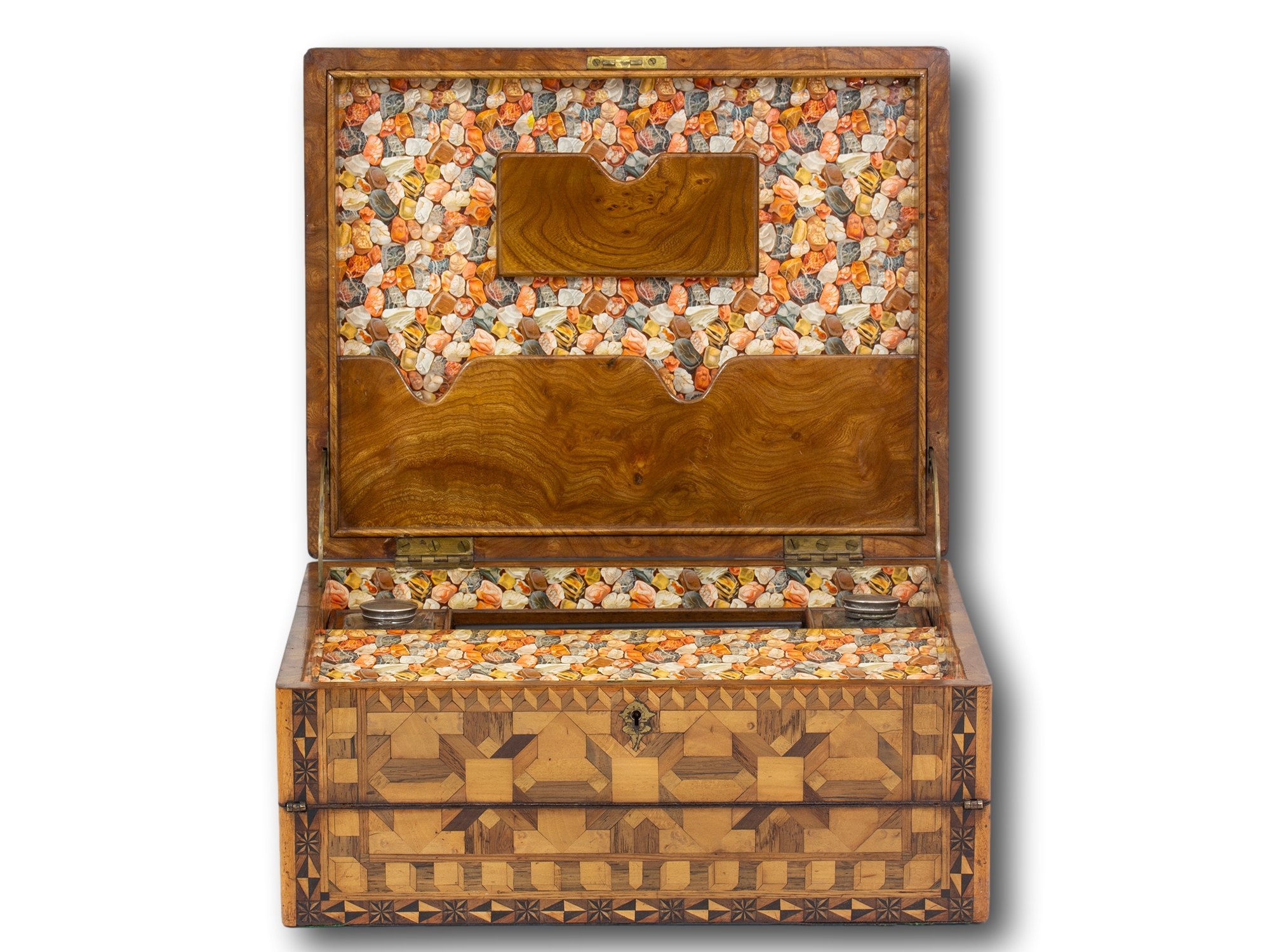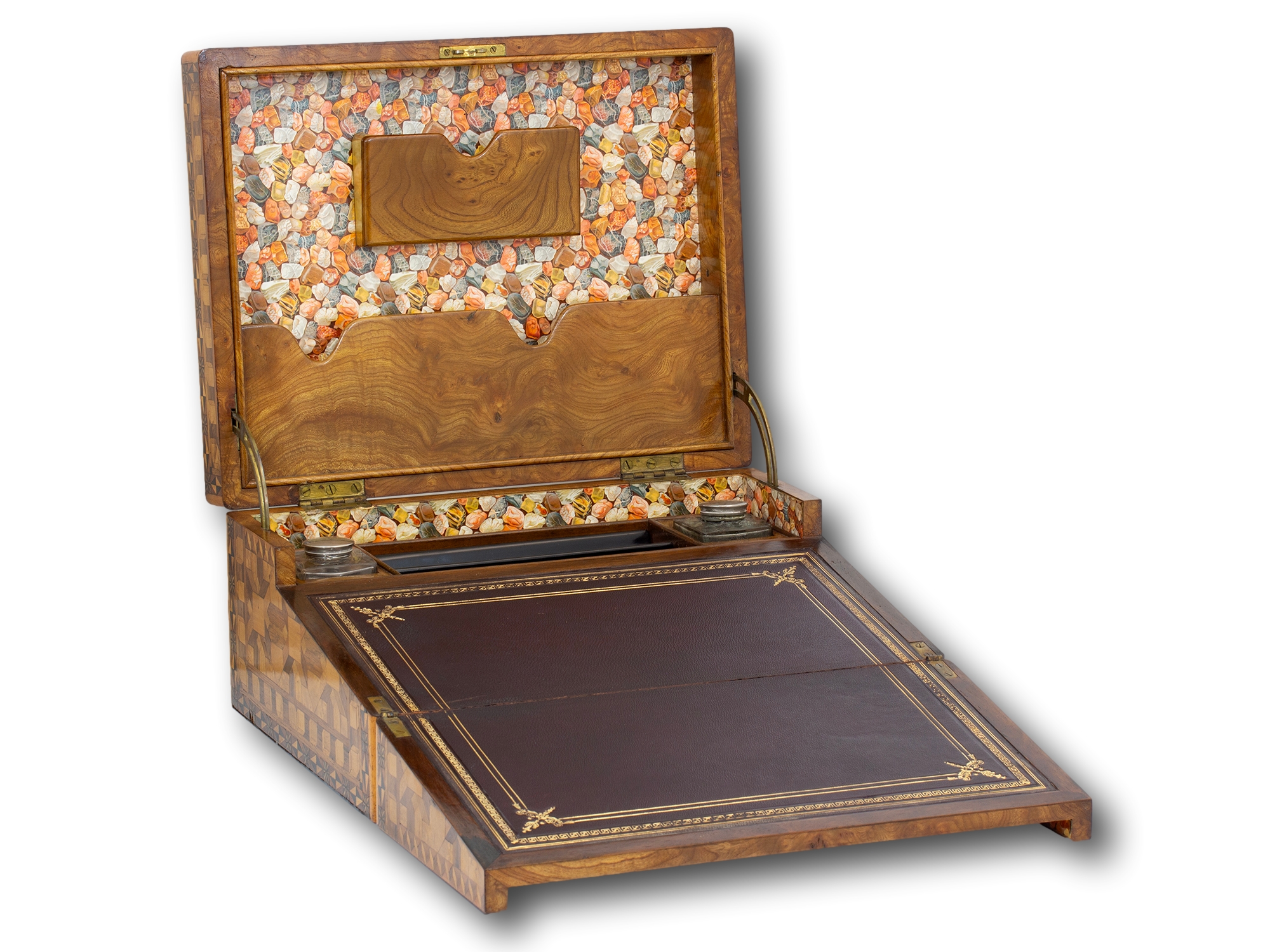Geometric Writing Slope John Wallace
SOLD
Featuring over 6000 Inlaid Pieces From our Writing Boxes collection, we are thrilled to offer this Geometric Writing Slope by John Wallace. The Writing Slope of rectangular form with curved corners is extensively decorated with a selection of inlaid woods... Read More
John Wallace of Glasgow
| Dimensions | 37.5 × 30 × 17.5 cm |
|---|---|
| Country | |
| Medium | Birdseye Maple, Ebony, Leather, Oak, Rosewood, Ash, Horse-Chestnut, Lime |
| Period | |
| Year | |
| SKU | 501254TRCE |
Description
Description
Featuring over 6000 Inlaid Pieces
From our Writing Boxes collection, we are thrilled to offer this Geometric Writing Slope by John Wallace. The Writing Slope of rectangular form with curved corners is extensively decorated with a selection of inlaid woods formed into geometric patterns to the exterior. Each border with layered symmetrical patterns including stars, chevrons, cubes and diamonds. The woods include Ebony, Rosewood, Maple, Birds Eye Maple, Ash, Oak, Lime and Horse-Chestnut. When opened the writing slope reveals the original ‘pebble’ lining, a dark purple leather slope with gold tooling and various compartments for inkwells, pens and documents. The Writing Slope is accompanied with an original retailers label which states that the writing slope contains over 6000 separate pieces including Oak which was part of a tree on the grounds of the Old College of Glasgow, Horse-Chesnut and Lime Trees grown in Kelvingrove Park and on site of Exhibition. Ash Root of Doom Tree from the Earl of Homes Estate at Douglas Lanarkshire. The box was manufactured by John Wallace of 9 Clifton St. Glasgow. The Writing Box dates to the Victorian period during the reign of Queen Victoria circa 1885.
The Writing slope comes complete with a working lock and tasselled key.
Ebony is often almost completely black with very little visible grain often with a subtle red/purple hue. This wood is very expensive due to the slow-growing trees which can often be gnarly affecting the yield of straight workable wood. Most ebonies are very dense making work with hand tools very difficult and can quickly clunt cutting tools. This density however offers an excellent finish on turned items.
Rosewood has many variations. Indian Rosewood, Madagascan Rosewood, Mexican Rosewood, Rio Rosewood, Brazilian Rosewood, San Dominican and Santos Rosewood. All types are prized for their grain and colour. Generally, the colours range from a medium-dark red-reddish brown.
Birdseye Maple is not a distinct species of maple. It is a growth variant of hard maple wood. Found in Northeastern America. The name derives from the appearance of tiny knots in the grain which resemble small bird’s eyes. This unique appearance is formed when the tree starts to grow new shoots in poor growing conditions and they are aborted leaving behind tiny knots.
Ash also known as White Ash, grows in Europe and North America. It is cream-yellow in colour with subtle grain patterns which can have a ripple effect. Ash Burr is rare to be clean and often shows marks from ingrown bark and knots. Often as Olive trees mature they can develop a darker yellow-brown colour.
Oak has many global variations. European Oak, also known as English or French Oak, is found in Europe. It is a well known and very popular wood due to its different types and strength yielding many uses. It can have a very simple clean look or a highly figured finish varying from tree to tree. European Oak can be Golden-yellow to light-brown in colour. Brown Oak is from the United Kingdom and its name is derived from its red-brown colour which is resulted from an attack by “beef-steak” fungus. This usually gives the wood an even colour, however, sometimes the wood can be streaked with a light brown giving it the name Tiger Oak.
Lime is characterized by light heartwood, white-yellow with reddish-brown shades. Sapwood is hardly distinguishable from heartwood. The lime tree tends to yellow in sunlight and temperature fluctuations should generally be avoided. Limewood was a favourite material of sculptors, carvers and turners because the wood is very easy to work.
Horse-Chestnut is Native to eastern Europe but also cultivated in temperate regions worldwide. The Heartwood is creamy white or yellowish brown, not clearly seperated from the white sapwood. Horse chestnut is generally easy to work but it’s low density and interlocked grain can lead to fuzzy surfaces however it glues and finishes well.
Victorian, an era of British History corresponding approximately with the reign of Queen Victoria from the 20th of June 1837 until her death on 22 January 1901 however, there are arguments stating that the Victorian era is actually from 1820 until 1914 proceeded by Georgian era and followed by the Edwardian era.
Every purchase made from Mark Goodger Antiques is accompanied by a comprehensive suite of documents to ensure your satisfaction and peace of mind. This includes our latest catalogue, a Certificate of Authenticity, detailed care instructions for your chosen item, and an independent invoice for insurance purposes. Additionally, your purchase is protected by our no-hassle, money-back policy, and your item will be fully insured during the shipping process to safeguard against damage or loss.
Additional information
Additional information
| Dimensions | 37.5 × 30 × 17.5 cm |
|---|---|
| Country | |
| Medium | Birdseye Maple, Ebony, Leather, Oak, Rosewood, Ash, Horse-Chestnut, Lime |
| Period | |
| Year | |
| SKU | 501254TRCE |














